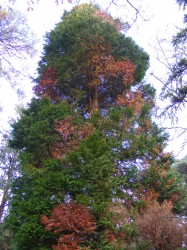Lawson cypress or Leyland cypress?
Brown or bronze foliage may suggest a Phytophthora lateralis infection in Lawson cypress conifers.
Many people find it difficult to distinguish between Lawson cypress (Chamaecyparis lawsoniana) and the similar Leyland cypress (Cupressocyparis leylandii). Both conifer species can develop brown foliage, but this may not be a symptom of P. lateralis infection.
 In fact, P. lateralis has never been confirmed infecting Leyland cypress. Brown foliage in this species is typically due to cold winter temperatures or aphid attack.
In fact, P. lateralis has never been confirmed infecting Leyland cypress. Brown foliage in this species is typically due to cold winter temperatures or aphid attack.
Lawson cypress is typically planted as an ornamental tree. It is an evergreen conifer with flat fern-like foliage, scales rather than needles and small cones that (when present) are about 1 cm or less in diameter. Crushed Lawson cypress foliage smells of parsley; a resinous, acrid smell suggests you have a Leyland cypress specimen.
How we can help
- Find out more about symptoms, with pictures to aid diagnosis
- Contact our Tree Health Diagnostics and Advice Service to help you identify Lawson cypress and confirm infection from samples
